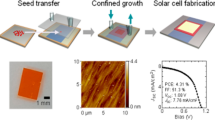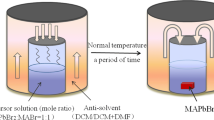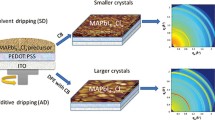Abstract
Organic and inorganic hybrid perovskites have attracted significant attentions due to their impressive optoelectronic properties. MAPbBr3, one of the most popular members in MAPbX3 (MA = methyl ammonium and X = Cl, Br, I) family, is considered as new generation optoelectronic materials, especially in the field of solar cells. Compared to polycrystalline films, MAPbBr3 single crystal is deemed more ideal for optoelectronic device because of fewer grain boundaries. To realize a controlled crystal growth, a thorough understanding of its growth mechanism, especially the role of surface structures played in growth kinetics, is of paramount importance. In this paper, hillocks on (100) facet of MAPbBr3 crystal were observed using atomic force microscopy when grown from N-dimethylformamide (DMF) solution. The results revealed that the growth of (100) facet was controlled by 2D nucleation at low concentration, which derived plenty of elementary steps whose height was about 0.59 nm, equivalent to one unit cell. Then the growth transferred to step flow model along [011] direction. Step flow ceased when encountering holes on the terraces. The optical morphologies validated that cubic plates were prone to growing along [011] directions, which were in a layer-by-layer model. Moreover, the temperature reverse solubility of MAPbBr3 in DMF solution was measured. In terms of the solubility and growth mechanism of MAPbBr3, a series of MAPbBr3 single crystals were successfully grown from thin cubic plates to thick and perfect cubes via temperature controlling rising method ultimately.







Similar content being viewed by others
References
Li Y, Yan W, Li Y et al (2014) Direct observation of long electron-hole diffusion distance in CH3NH3PbI3 perovskite thin film. Sci Rep 6:1–7
Dang Y, Liu Y, Sun Y et al (2014) Bulk crystal growth of hybrid perovskite material CH3NH3PbI3. CrystEngComm 17:665–670
Yan K, Long M, Zhang T et al (2015) Hybrid halide perovskite solar cell precursors: colloidal chemistry and coordination engineering behind device processing for high efficiency. J Am Chem Soc 137:4460–4468
Su J, Chen DP, Lin CT (2015) Growth of large CH3NH3PbX3 (X = I, Br) single crystals in solution. J Cryst Growth 422:75–79
Liu Y, Yang Z, Cui D et al (2015) Two-inch-sized perovskite CH3NH3PbX3 (X = Cl, Br, I) crystals: growth and characterization. Adv Mater 27:5176–5183
Brittman S, Garnett EC (2016) Measuring n and k at the Microscale in Single Crystals of CH3NH3PbBr3 Perovskite. J Phys Chem C 120:616–620
Liu J, Xue Y, Wang Z et al (2016) Two-dimensional CH3NH3PbI3 perovskite: synthesis and optoelectronic application. ACS Nano 10:3536–3542
Chen Q, De Marco N, Yang Y et al (2015) Under the spotlight: the organic–inorganic hybrid halide perovskite for optoelectronic applications. Nano Today 10:355–396
Fu Y, Meng F, Rowley MB et al (2015) Solution growth of single crystal methylammonium lead halide perovskite nanostructures for optoelectronic and photovoltaic applications. J Am Chem Soc 137:5810–5818
Nie W, Tsai H, Asadpour R et al (2015) High-efficiency solution-processed perovskite solar cells with millimeter-scale grains. Science 347:522–525
Meng K, Gao S, Wu L et al (2016) Two-dimensional organic–inorganic hybrid perovskite photonic films. Nano Lett 16:4166–4173
Tian W, Zhao C, Leng J et al (2015) Visualizing carrier diffusion in individual single-crystal organolead halide perovskite nanowires and nanoplates. J Am Chem Soc 137:12458–12461
Zhu H, Fu Y, Meng F et al (2015) Lead halide perovskite nanowire lasers with low lasing thresholds and high quality factors. Nat Mater 14:636–642
Ren X, Yang Z, Yang D (2016) Modulating crystal grain size and optoelectronic properties of perovskite films for solar cells by reaction temperature. Nanoscale 8:3816–3822
Saidaminov MI, Abdelhady AL, Murali B et al (2015) High-quality bulk hybrid perovskite single crystals within minutes by inverse temperature crystallization. Nat Commun 6:7586(1–6)
Zhao P, Xu J, Dong X et al (2015) Large-size CH3NH3PbBr3 single crystal: growth and in situ characterization of the photophysics properties. J Phys Chem Lett 6:2622–2628
Sang L, Hao M, Wang W et al (2016) Growth, structure and morphology of CH3NH3PbBr3 single crystal. J Chin Ceram Soc 44:540–544
Shi D, Adinolfi V, Comin R (2015) Low trap-state density and long carrier diffusion in organolead trihalide perovskite single crystals. Science 347:519–522
Georgiev P, Bojinova A, Kostova B et al (2013) Implementing atomic force microscopy (AFM) for studying kinetics of gold nanoparticle’s growth. Colloids Surf A Physicochem Eng Asp 434:154–163
Jordan G, Higgins SR, Eggleston CM et al (2001) Dissolution kinetics of magnesite in acidic aqueous solution, a hydrothermal atomic force microscopy (HAFM) study: step orientation and kink dynamics. Geochim Cosmochim Acta 65:4257–4266
Braga D, Grepioni F (2007) Making crystals by design. Wiley-VCH Verlag GmbH and Co. KGaA, Weinheim, pp 39–41
Naiben Min N (1982) Physics basic of crystal growth. Shanghai Science and Technology Press, Shanghai, pp 283–338
Mercier N, Riou A (2004) An organic–inorganic hybrid perovskite containing copper paddle-wheel clusters linking perovskite layers: [Cu(O2C–(CH2)3–NH3)2]PbBr4. Chem Commun 10:844–845
Grancini G, Kandada ARS, Frost JM et al (2015) Role of microstructure in the electron–hole interaction of hybrid lead halide perovskites. Nat Photon 9:695–701
Acknowledgements
This work was financially supported by the National Natural Science Foundation of China (No. 51202131), Science Foundation of Shandong Province (ZR2016EMQ10), Scientific Research Foundation of Shandong University of Science and Technology for Recruited Talent (No. 2014RCJJ001), SDUST Research Fund and Joint Innovative Center for Safe and Effective Mining Technology and Equipment of Coal Resources, Shandong Province (No. 2014JQJH102). Distinguished Taishan Scholars in Climbing Plan (No. tspd20161006).
Author information
Authors and Affiliations
Corresponding authors
Rights and permissions
About this article
Cite this article
Ding, J., Zhao, Y., Du, S. et al. Controlled growth of MAPbBr3 single crystal: understanding the growth morphologies of vicinal hillocks on (100) facet to form perfect cubes. J Mater Sci 52, 7907–7916 (2017). https://doi.org/10.1007/s10853-017-0995-8
Received:
Accepted:
Published:
Issue Date:
DOI: https://doi.org/10.1007/s10853-017-0995-8




